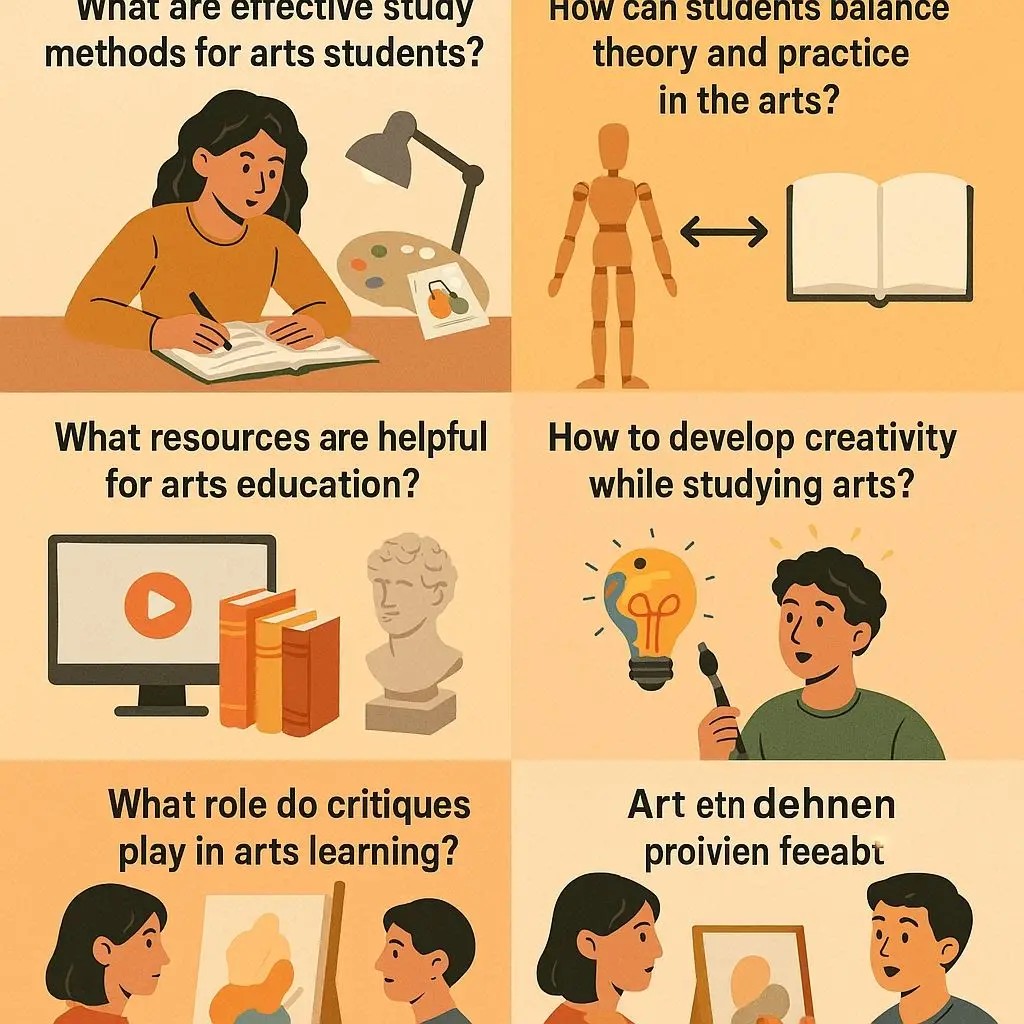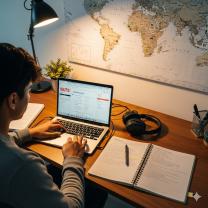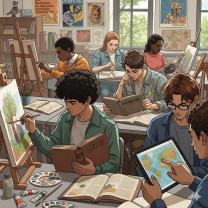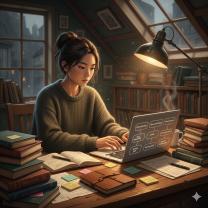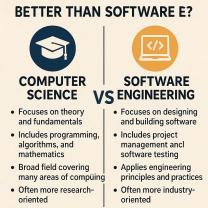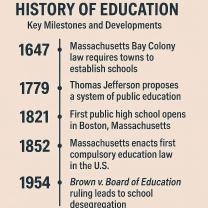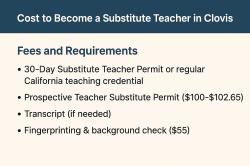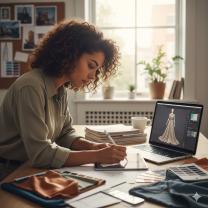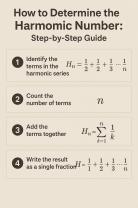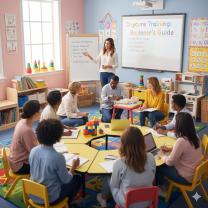How should students study the Arts?
Studying the Arts effectively combines both practice and understanding. Here’s a simple guide for students to get the most out of their Arts learning:
1. Immerse Yourself in the Art Form
Observe deeply: Look at artworks, performances, or creations carefully. Notice details like technique, color, emotion, and composition.
Experience widely: Visit museums, galleries, theaters, and concerts to expose yourself to different styles and cultures.
2. Practice Regularly
Hands-on creation: Draw, paint, dance, play an instrument, write, or act often to build skills.
Experiment: Don’t be afraid to try new materials, styles, or ideas. Mistakes help you grow.
3. Learn the Fundamentals
Study basics like color theory, composition, perspective, rhythm, or storytelling depending on the art form.
Understand key historical movements and influential artists to see how art has evolved.
4. Reflect and Analyze
Keep a journal or sketchbook to record your thoughts, inspirations, and progress.
Critique your own work and others’ with constructive questions: What works? What could improve? Why does it impact me?
5. Seek Feedback and Collaboration
Share your work with teachers, peers, or online communities to get different perspectives.
Collaborate on projects to learn teamwork and new techniques.
6. Manage Your Time and Environment
Set aside regular, distraction-free study/practice time.
Create a comfortable and inspiring space for your art.
7. Connect Theory and Practice
Balance reading about art theory and history with active creation.
Apply concepts you learn immediately to your work.
8. Stay Curious and Open-Minded
Explore new genres, cultures, and methods continuously.
Attend workshops, talks, or online courses.
Absolutely! Here are specific study plans and resources tailored for different art forms to help students study more effectively:
1. Visual Arts (Drawing, Painting, Sculpture)
Study Plan
Week 1–2: Learn basic drawing skills — shapes, lines, shading. Use sketchbooks daily.
Week 3–4: Study color theory and practice mixing colors. Experiment with different media (watercolors, acrylics).
Week 5: Analyze famous artworks; visit a gallery or virtual museum tour.
Week 6: Create a final project applying techniques learned.
Resources
Books: Drawing on the Right Side of the Brain by Betty Edwards
Online:
Proko (YouTube) — Drawing tutorials
Drawspace — Free lessons
Google Arts & Culture — Virtual museum tours
2. Music (Instrumental, Vocal, Theory)
Study Plan
Daily: Practice scales and basic pieces (15–30 min).
Weekly: Learn music theory basics (reading notes, rhythm).
Biweekly: Listen to various genres, analyze structure and instruments.
Monthly: Perform for friends/family or record yourself for feedback.
Resources
Apps: Yousician, Simply Piano
Websites:
MusicTheory.net — Theory lessons
JustinGuitar — Guitar tutorials
Books: Alfred’s Basic Piano Library or Essential Elements for Band
3. Drama & Theater
Study Plan
Week 1: Learn acting basics — body language, voice control, improvisation exercises.
Week 2: Study famous plays and monologues; practice reading aloud.
Week 3: Work on scene study with a partner or group.
Week 4: Perform a short scene or monologue and get feedback.
Resources
Books: An Actor Prepares by Constantin Stanislavski
Online:
Backstage — Audition tips and acting advice
National Theatre (YouTube) — Performances and workshops
Apps: Rehearsal Pro for script practice
4. Digital Arts (Graphic Design, Animation, Video Editing)
Study Plan
Week 1: Get familiar with basic software tools (Photoshop, Illustrator, or free alternatives like GIMP).
Week 2: Practice basic design principles (composition, typography, color).
Week 3: Learn animation basics or video editing techniques.
Week 4: Create a small project like a poster, short animation, or video.
Resources
Free Software: GIMP, Blender (3D/animation), DaVinci Resolve (video)
Online Courses:
Canva Design School — Design basics
Blender Guru (YouTube) — Blender tutorials
Adobe Tutorials — Official guides
1.Effective study methods for arts students blend traditional academic techniques with practical, hands-on approaches. Students should focus on methods that help them analyze, create, and reflect on their work and the work of others.
What Are Effective Study Methods for Arts Students?
Effective study methods for arts students often combine academic rigor with creative practice. A few key strategies include:
Active Viewing and Listening: Don't just passively consume art. When studying a piece, actively analyze its composition, technique, and historical context. Ask questions like: "What is the artist's message?" and "How did they achieve this effect?"
Journaling and Sketchbooks: Keep a detailed journal to record observations, ideas, and reflections. A sketchbook is essential for visual artists to practice techniques and develop concepts. This is where you can brainstorm, experiment, and capture fleeting ideas.
Case Studies: Analyze the work of a specific artist, movement, or period in depth. This helps you understand the historical and theoretical context behind the art.
Peer Critiques: Regularly share your work with peers to get feedback and learn to articulate your artistic choices. This collaborative process sharpens both your creative and analytical skills.
How Can Students Balance Theory and Practice in the Arts?
Balancing theory and practice is crucial for a well-rounded arts education. Theory provides the foundational knowledge and historical context, while practice allows you to apply that knowledge and develop your skills. To achieve this balance, try to:
Integrate Theory into Practice: When you learn about a historical art movement, create a piece inspired by its techniques or themes. For example, after studying Impressionism, you could try painting with a similar color palette and brushwork.
Use Practice to Inform Theory: As you create, you will encounter problems and make discoveries. Use these practical experiences to inform your theoretical understanding. For instance, you might realize why a particular medium was chosen by an artist to create a specific texture.
Dedicate Time to Both: Schedule specific time slots for both reading and research (theory) and for creating (practice). Avoid letting one dominate the other.
What Resources Are Helpful for Arts Education?
Helpful resources for arts education extend beyond textbooks and studio supplies.
Museums and Galleries: Visiting museums and galleries is one of the best ways to experience art firsthand. Many offer student discounts or free admission days.
Online Archives and Databases: The Internet Archive, Google Arts & Culture, and museum websites provide access to high-resolution images, digitized documents, and virtual tours.
Art Books and Publications: Books, both historical and contemporary, offer in-depth analyses of artists, movements, and techniques.
Documentaries and Interviews: Watching documentaries and interviews with artists can provide insights into their creative processes and philosophies.
Workshops and Community Classes: These provide opportunities to learn new skills, experiment with different mediums, and connect with other artists.
How to Develop Creativity While Studying Arts?
Developing creativity is not just about having innate talent; it's a skill that can be cultivated through deliberate practice.
Experimentation: Don't be afraid to try new materials, techniques, and ideas, even if they seem unconventional. Embrace failure as a part of the learning process.
Explore Different Disciplines: Study art forms outside your primary focus. A painter might find inspiration in music, or a writer might be inspired by sculpture.
Observe the World: Pay close attention to your surroundings—the colors, shapes, and textures. Carry a sketchbook or camera to capture what you see.
Brainstorming and Mind Mapping: Use these techniques to generate a large number of ideas without judgment. You can refine them later.
What Role Do Critiques Play in Arts Learning?
Critiques are a fundamental part of arts education. They serve several vital roles:
Constructive Feedback: Critiques provide an opportunity for students to receive objective feedback on their work from instructors and peers. This helps them identify strengths and weaknesses.
Articulating Intent: A critique forces an artist to verbalize their choices and intentions. This process helps them clarify their own artistic vision and defend their creative decisions.
Learning to Receive and Give Feedback: Critiques teach students how to accept feedback gracefully and how to provide thoughtful, constructive criticism to others.
Building Community: They foster a sense of community and intellectual exchange among artists, creating a supportive environment for growth.
